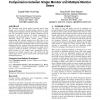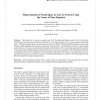265 search results - page 10 / 53 » Differences Triple Spaces = Active Triple Spaces |
IROS
2007
IEEE
15 years 6 months ago
2007
IEEE
Abstract— This paper addresses locomotion with active balancing, via task space control with prioritization. The center of gravity (COG) and foot of the swing leg are treated as ...
97
Voted
AAAI
2006
15 years 1 months ago
2006
Assume that we are trying to build a visual recognizer for a particular class of objects--chairs, for example--using existing induction methods. Assume the assistance of a human t...
AVI
2004
15 years 1 months ago
2004
The continuing trend toward greater processing power, larger storage, and in particular increased display surface by using multiple monitor supports increased multi-tasking by the...
HICSS
1999
IEEE
15 years 4 months ago
1999
IEEE
As computer networks improve, more social and work interactions are carried out "virtually" by geographically separated group members. In this paper we discuss the desig...
115
Voted
JCNS
1998
15 years 3 days ago
1998
The firing rate of neurons in parietal area 7a of the behaving Rhesus monkey with its head fixed incorporates both visual and eye position information. This neural tuning is not ...


